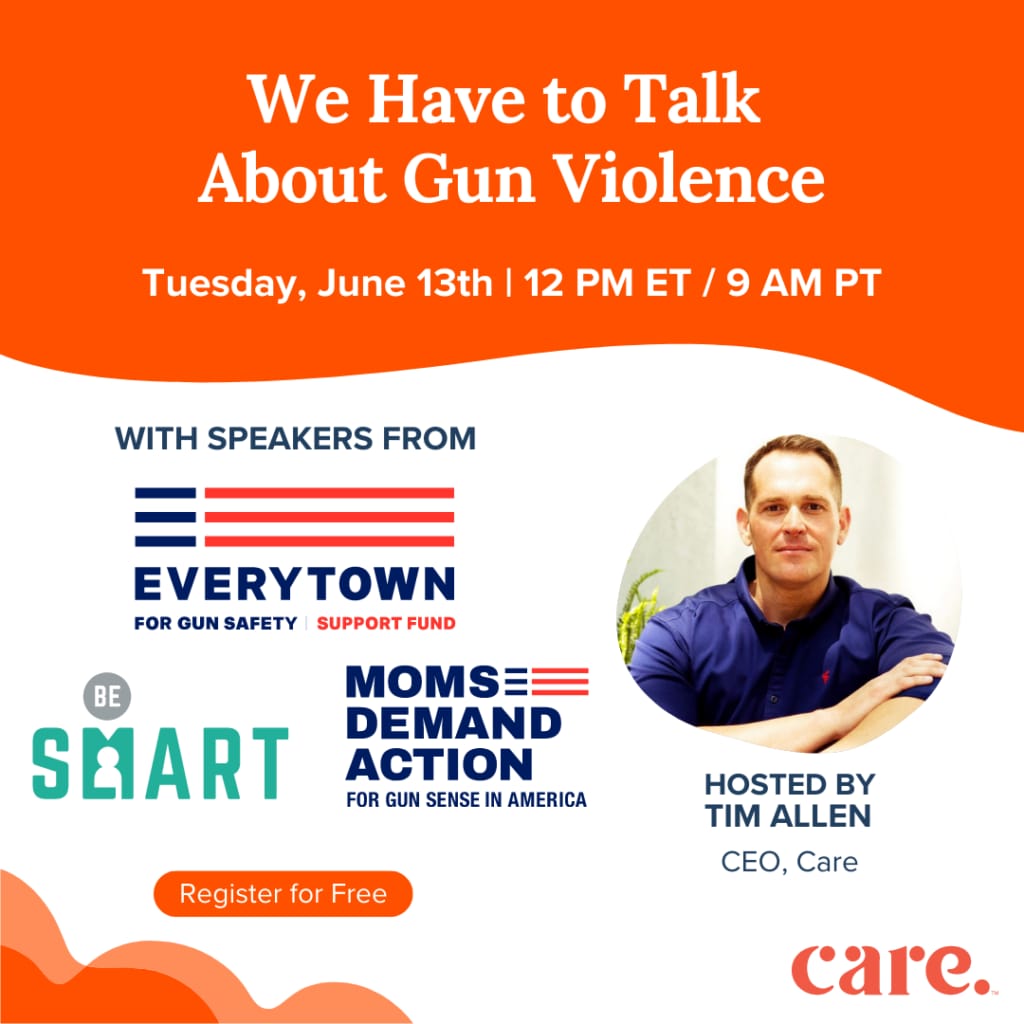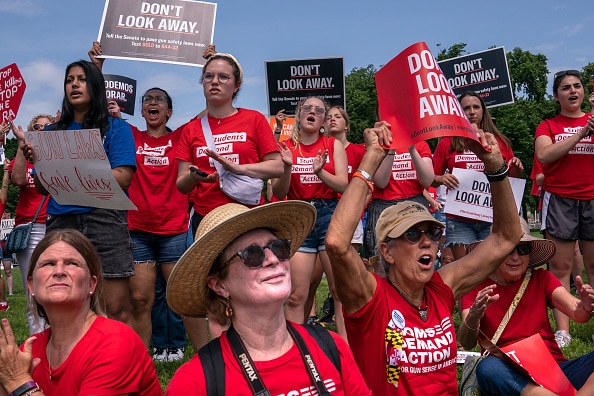For many American families, gun violence has become an urgent and ever-present concern, and it isn’t hard to see why. In the past two years, guns have overtaken car accidents and other threats as the leading cause of death for U.S. kids. And, within the first five months of 2023, more than 17,000 people have lost their lives to guns. It’s no wonder why a recent survey by the Pew Research Center found that 45% of parents are very or somewhat worried about their child getting shot.
Contrary the fights we see online and in the media, gun violence prevention isn’t that controversial. A majority of Americans agree that gun violence is a problem, and they support common sense gun laws, like background checks, mental health restrictions and red flag laws that remove firearms from high-risk individuals.
Last year, Congress passed new gun legislation for the first time in 30 years, but many states still haven’t taken meaningful action and the threat of gun violence hasn’t decreased. So, what else can we do? We asked some of the leading gun violence activists who fight for progress on this issue every single day. Here’s what they say parents and caregivers can do in 2023 to aid in their fight to stop gun violence and make real progress towards saving lives.
1. Stop letting politics prevent progress.
One major thing standing in the way of gun violence prevention: focusing on politics instead of safety, notes Tony Montalto, the president of Stand With Parkland and a father whose daughter Gina was killed in a shooting at Marjory Stoneman Douglas High School in Parkland, Florida.
“Safety isn’t political,” he says. “If you go to a room full of Republicans and ask if they want safe schools, everybody raises their hand. Ask a room full of Democrats, you get the same answers. We agree on 80% of it, but instead of focusing on what we’re united about, we focus on these smaller pieces that divide us.”
Every gun safety advocate we spoke with has experience working with politicians, activists and volunteers who have a wide range of views on gun rights and gun safety. Instead of debating political points, here’s what they recommend:
- Meet people where they are.
- Find your common goals.
- Stay open to compromise.
- Focus on action and progress, not 100% agreement.
Johanna Thomas, an Arkansas Moms Demand Action leader and educator on gun violence prevention through the Be SMART program has seen firsthand how a change of perspective can shift the conversation.
“I’ve presented Be SMART all over the country, and most people are just surprised once they realize we’re not here to talk about removing guns or to infringe upon anyone’s rights,” she says. “We just want people to be safe.”
“I know firsthand that legislators listen to the squeaky wheel. Get involved: email, call, ask for a meeting. Let them know you want change and you are watching.”
— KRISTIN SONG, PRESIDENT OF THE ETHAN MILLER SONG FOUNDATION
2. Relentlessly engage with your community leaders.
“A majority of people support life-saving gun legislation but are not actively involved in pushing for change,” says Kristin Song, the president of the Ethan Miller Song Foundation, who worked to pass Ethan’s Law in Connecticut after her 15-year-old son was killed in an accidental shooting.
Song is working to bring Ethan’s Law to other states and to Congress. In the process, she’s met with hundreds of congresspeople, including every Democrat and 120 Republicans in the U.S. House prior to the 2022 election, and she stresses that constant pressure is the key to creating change.
“I know firsthand that legislators listen to the squeaky wheel,” she says. “Get involved: email, call, ask for a meeting. Let them know you want change and you are watching.”
When gun tragedies occur or life-saving legislation isn’t passed, the next step is to hold those leaders accountable, adds Gloria Pan, Senior Vice President and the lead of gun violence campaigns for Moms Rising.
“Do the work and look at how your senators and representatives have voted on key pieces of gun violence legislation over the last few years,” she says. “Know where they stand and whether or not certain legislation is moving forward. If there’s another horrible, horrific mass shooting, make that phone call. Tell them you know they’ve been standing in the way of any kind of reform and ask them why that is.”
3. Take an active role in preventing school shootings.
Montalto stresses the importance of working to ensure schools have access to the programs and resources they need to identify threats, support students’ mental health and prevent school shootings.
This can include putting pressure on legislators to fund these initiatives. You can also point school leadership to schoolsafety.gov, a site provided by the U.S. Departments of Homeland Security, Justice and Education where educators can find information on how to prevent violence and address threats, as well as access to grants for resources and materials.
To help ensure your own child’s safety at school, the Stand With Parkland website offers a list of questions every parent should ask their child’s school officials. They include things like:
- Is there a way for students and staff to report threats?
- How are parents notified when a threat is made at school?
- Does the school have an active shooter policy?
The list also explains what kinds of answers you should expect to hear from school officials so you can know if more work needs to be done.
Read more:
4. Normalize gun safety conversations with family and friends.
Guns should be brought up prior to playdates and other gatherings just like allergies, pets or any other household safety topic, Thomas says.
Before a playdate, Thomas says she typically sends a text saying something like, “Hi, I’m [child’s name] parent. Just so you know, we have four friendly dogs. We have a swimming pool that has an alarm and is monitored. We keep alcohol locked up and medications in a safe. We have firearms. They are kept in our gun safe unloaded and the ammunition is stored separately. Does your child have any allergies?”
You never know if someone has an unsecured gun, and the consequences of not asking can be tragic. “The first time I ever asked another parent about a firearm, my child was going on a playdate,” she adds. “The mom said, ‘I have a firearm in my car,’ and when I asked if it was secured, she said she kept it under the seat.”
The revelation shocked Thomas, but it also gave her a chance to work with the other parent to protect their kids. “I had to say, ‘Can we come up with a plan for securing that gun while my child is at your home?’ And she was like, ‘Oh, absolutely,’” she explains. “I think we all want to be responsible gun owners, but not everyone knows what that means.”
5. Don’t ignore the racialized history of gun violence in America.
Debates over gun rights in the U.S. are inextricably linked to other parts of our history, Pan says, including our country’s history of slavery and the ongoing fight for racial justice and civil rights.
“It’s very important to understand the racial aspects of the Second Amendment and gun rights and the history of it because, unless you understand it, you cannot understand the racialized forms of gun violence that we still experience today,” she explains.
This includes lessons like:
- How the Second Amendment came to be interpreted as an individual right.
- What role historical militias played in upholding slavery.
- How communities and people of color are targeted by racialized gun violence.
“Gun violence is not always racialized, but racial tensions and the racial history behind who is allowed to own guns and who is most harmed by guns are a driving factor in the public discussion and why it’s so hard to get any kind of gun violence policy reform,” Pan says.

Sign up for our free webinar here
6. Don’t underestimate the risks guns pose to kids.
“Parents need to understand that guns are the leading cause of death in children 0-19, meaning your child has a higher chance of being killed by a gun than any other danger facing them,” Song says.
As parents, Song says we need to take the risk seriously and take steps to protect kids from harm. “Please do not lull yourself into a false sense of security that just because your child has gone through the NRA safety class, grown up with guns or has been told not to touch guns that they’ll listen,” she explains.
“Remember, children and teens are reckless and impulsive,” she adds. “We need to create a cultural shift where it becomes second nature to secure guns if children can gain access to them.”
“If you are interested in and upset that gun violence is about race, about justice, about who gets harmed disproportionately and who has the guns, look for the groups who are fighting for civil rights and fighting against violence in general.”
— GLORIA PAN, SENIOR VICE PRESIDENT, MOMS RISING
7. Support a wider range of anti-violence organizations.
Mainstream gun violence prevention organizations, like Moms Demand Action, do an incredible job of moving laws forward, Pan says, but there are many other groups that also need support, donations and volunteers. This can include local organizations fighting for racial justice, against domestic violence, and for the safety and equality of marginalized groups.
“If you are interested in and upset that gun violence is about race, about justice, about who gets harmed disproportionately and who has the guns, look for the groups who are fighting for civil rights and fighting against violence in general,” she says. “They’re all interested in gun violence. They may not be in the trenches fighting for legislation, but join the fight against violence, period.”
8. Remember there’s more than one way to fight to stop gun violence.
“Not everybody’s going to become a national spokesperson,” says Thomas. “Not everybody is going to be at the Capitol. I like to remind people that this is a huge table.”
Thomas says a great first step for getting involved is just showing up to a meeting of your local Moms Demand Action chapter or another organization of your choice. Other helpful ways to get involved include:
- Going through Be SMART training to learn about gun safety.
- Talking to your school board about gun violence prevention.
- Talking to neighbors, friends and family about secure firearm storage.
- Sharing information about anti-gun violence initiatives, demonstrations and campaigns.
Thomas concludes, “There’s something for everyone to do, whether that’s phone banking, whether that’s conversations with professionals or whether that is talking to your legislators. It doesn’t have to be huge to make a difference.”






